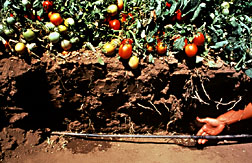Trickle-L Spreads Irrigation Know-How
|
|
Need a fast, easy, inexpensive way to get an answer to a question about drip-irrigating an orchard, field, golf course, or garden?
Try the Internet discussion group called Trickle-L.
"If you post a question in the morning, you're likely to start getting answers from experts all over the world in just a few hours," says Agricultural Research Service agricultural engineer Thomas J. Trout. He directs the ARS Water Management Research Laboratory in Fresno, California, where Trickle-L was launched in 1994.
Trout says Trickle-L users include about 500 growers, scientists, extension agents, and irrigation equipment manufacturers—and likely some greenhouse managers, landscapers, and amateur gardeners as well. Most are from the United States, though experts from about two dozen other countries also belong to this "virtual community" on the Internet.
Trickle-L is what is known as a "mailing list" (also "listserv"), or subject-specific group. When a member of the group posts a message, that communication is automatically sent within a few minutes to the e-mail address of all other members.
"It's somewhat like a 24-hour electronic post office," says Richard M. Mead, who created Trickle-L while a soil scientist at the Fresno laboratory. Now a cooperator, Mead did the work with the aid of Jerome Pier, who was then at the University of Nebraska-Lincoln.
Trickle-L gets its name from the above ground and underground (buried) drip-irrigation systems that deliver precise amounts of water to plants via tiny microsprayers or through emitters that squeeze out water a drop at a time.
For some crops, especially high-value fruits and vegetables such as strawberries or broccoli, drip or trickle irrigation frequently brings bigger yields and higher profits than better known irrigation techniques like furrow systems or overhead sprinklers. And buried-drip irrigation is being tried on alfalfa in California, cotton in Texas, and corn in Kansas—crops not traditionally irrigated this way.
"Admittedly," says Trout, "drip irrigation can have higher installation and maintenance costs. But the technology gives growers an unparalleled degree of precision in delivering water and fertilizer—or other farm chemicals—to plants. That saves water and prevents overuse of fertilizers that might otherwise leach into underground water supplies."
Trickle-L users incur no cost to join this cyberspace club, other than the expense of an Internet connection with e-mail.
|
To subscribe to Trickle-L: Address e-mail to Listserv@listserv.unl.edu . As the message, paste the command: To join Salinity-L: Address e-mail to Listserv@listserv.unl.edu . As the message, type the command: |
Trickle-L, Trout says, is "gaining a reputation as one of the best places on the Internet to go to for friendly, well-informed help with problems of setting up and running drip-irrigation systems."
Users of Trickle-L have turned to other members for advice on everything from how to stop gophers from gnawing on buried irrigation tubing to how to set up the most cost-effective drip system for watering raspberries or asparagus.
Trickle-L, adds Trout, gives scientists at the Water Management Research Laboratory, and at other ARS labs as well, an inside look at the everyday problems growers and irrigation managers face.
"It's one of the fastest ways for us to learn about new, real-world issues," he says. "That helps us improve our research."
What's more, Trickle- L serves as a forum for scientists' theoretical discussions on topics like evapotranspiration—plants' use of water.
In addition to Trickle-L, the Water Management Research Laboratory also provides two other Internet resources—Salinity-L and a World Wide Web site.
Salinity-L is a discussion group for growers, researchers, and others who want to exchange ideas on how to cope with—and forestall—buildup of salts on arid farmlands. Salinization is a natural process that irrigated farming inadvertently accelerates.
Richard W. Soppe, a visiting scientist with the Fresno laboratory, established this specialized group in l995, in collaboration with Charles Sundermeier, a computer systems manager at the University of Nebraska-Lincoln.
"Both the Trickle-L and the Salinity-L discussion groups," Trout notes, "have increased the Water Management Laboratory's visibility worldwide."
The laboratory's WWW site has also garnered new, international attention for the research center. It is an award-winning site. It lists recent publications from the laboratory staff, describes computer software available from the researchers, and highlights experiments under way at the lab's network of study sites throughout central and southern California.
Microirrigation Forum, newest in the cluster of electronic irrigation information sources, was started in 1996 by Mead. "Microirrigation," he explains, "is the term used internationally to describe drip or trickle irrigation."
Still maintained by Mead, the forum lists other irrigation-related Internet sites; announces forthcoming meetings, conferences, and seminars; and archives some of the most useful discussions, called subject threads, from Trickle-L.
Internet users often refer back to Trickle-L discussions as the best source of information that might not be readily available elsewhere.
For example, an agronomist with one of the country's largest manufacturers of drip-irrigation equipment has frequently sent growers a copy of a 1996 Trickle-L discussion that explains how to correctly flush chlorine through irrigation tubing. The procedure kills bacteria or algae that could otherwise clog tiny emitters. — By Marcia Wood, ARS.
Thomas J. Trout is at the USDA-ARS Water Management Research Laboratory, 9611 S. Riverbend Ave. Parlier, CA 93727; phone (559) 596-2852.







